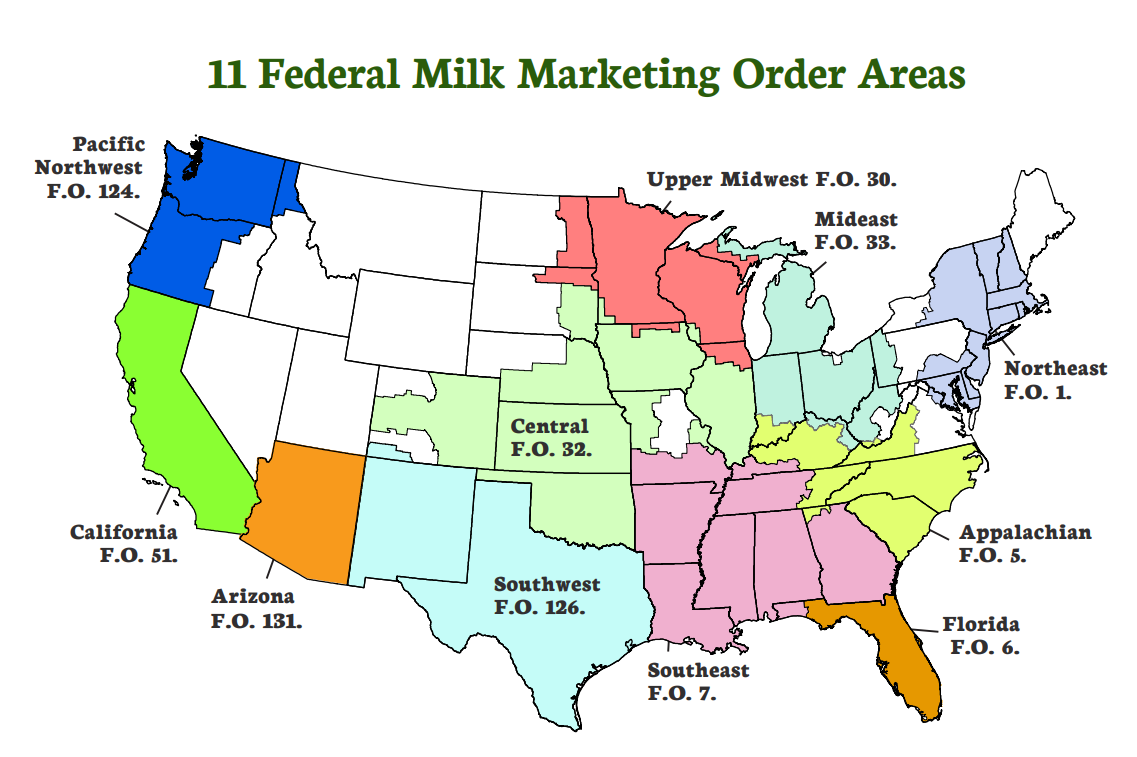Federal Milk Marketing Order
Unfavorable economic conditions, chaotic fluid-milk pricing, and dealers who squeezed farmers on prices in the early 20th century left farmers with low prices and disorderly markets. To return market power to producers, the federal government established the Federal Milk Marketing Order (FMMO) system in the 1930s.
FMMOs establish provisions under which dairy processors buy fresh milk from dairy farmers who supply a marketing area, maintaining stable marketing relationships for all handlers and producers and organizing the complex process of marketing fresh milk. USDA oversees the FMMO program, which includes 11 milk marketing orders and applies to about 75 percent of total U.S. milk production. Federal orders establish minimum prices paid to farmers, ensure payments to farmers are accurate and timely, and provide market information.
After a multiyear effort led by NMPF and its member cooperatives, comprehensive updates to the FMMO system were approved by dairy farmers in January 2025. USDA’s final rule included many of NMPF’s key concepts. Additional parts of NMPF’s member-led plan, including a mandatory cost survey for dairy processing plants, will require action by Congress.

Our Position
NMPF supports the FMMO system, as well as efforts to ensure dairy farmers and their cooperatives are paid for milk deliveries and improvements that increase clarity and producer understanding of milk pricing and ensure an orderly market and fair prices.
NMPF also supports the ability of cooperatives to vote as a bloc on FMMO issues, supporting the goal of dairy cooperatives to effectively market milk for the highest possible financial return to its farmer-owners.
NMPF continues to push for legislation that requires USDA to conduct mandatory plant-cost studies to better inform future make allowance discussions and for administrative action to extend the current 30-day reporting limit to 45 days on forward priced sales on nonfat dry milk and dry whey.
Key Points
- FMMOs exist to promote orderly marketing conditions in fluid milk markets, supervise terms of trade that achieve more equality of bargaining between dairy farmers and milk processors, and assure that consumers have an adequate dairy supply.
- USDA announced in January 2025 that all federal orders accepted the FMMO modernization plan that was shaped heavily by NMPF’s proposals. Highlights include:
- Returning the base Class I skim milk price formula to the higher-of the advanced Class III or Class IV skim milk prices for the month. USDA also created a Class I extended shelf life (ESL) adjustment for all ESL products equal to the average-of mover plus a 24-month rolling average adjuster with a 12-month lag.
- Updating Class III and IV manufacturing allowances for cheese, butter, nonfat dry milk and dry whey, and the butterfat recovery factor.
- Updating the Class I differential values to reflect the increased cost of servicing the Class I market.
- Updating skim milk composition factors.
- Removing 500-pound barrel cheddar cheese prices from the Dairy Product Mandatory Reporting Program survey.
- NMPF will continue to push for congressional action on proposals that require congressional authorization, including mandatory dairy manufacturing cost reporting for greater transparency.





